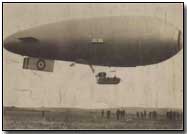Encyclopedia - Sea Scouts
 Sea Scouts, adopted by the
British Royal Naval Air Service (RNAS), comprised observation airships (or
'blimps' as they became known). In use from May 1915 the
Sea Scouts - which could be constructed rapidly and at minimal cost -
combined the fuselage of a BE-2C aircraft with a non-rigid shell.
Sea Scouts, adopted by the
British Royal Naval Air Service (RNAS), comprised observation airships (or
'blimps' as they became known). In use from May 1915 the
Sea Scouts - which could be constructed rapidly and at minimal cost -
combined the fuselage of a BE-2C aircraft with a non-rigid shell.
Sometimes used as convoy escorts the machines were chiefly used for patrol duties along the English Channel and Irish Sea where they were intended to seek out enemy German submarine and mining activity.
The SSZ model (Sea Scout Zero), introduced in September 1916, was the most popular of the three types of Sea Scout produced, with some 66 manufactured by the close of the war, each costing around £4,000-£5,000 to build; it was a marked improvement upon its immediate predecessor, the Sea Scout Pusher (SSP).
The Sea Scout's fuel tanks were contained in cylinders mounted on the envelope, and they powered a 75-horse power Rolls Royce Hawk water-cooled engine designed specifically for non-rigid airships. The maximum speed of the Sea Scout was approximately 85kph (thereby meeting a speed requirement for airships laid down earlier by First Sea Lord Admiral John Fisher).
The Sea Scout, some 112 feet long, was typically manned by three people: a wireless/telegraphist operator in the front cockpit (armed with a machine gun, chiefly to detonate floating mines), the pilot in the centre seat and an engineer aft. These craft could stay airborne for up to ten hours at a time.
Although Sea Scouts were able to carry cameras for reconnaissance purposes they were seldom fitted in this manner. An extension of Sea Scout design was the Coastal Class Airship.
A Kite Balloon was an observation balloon controlled by a cable from the ground.
- Did you know?
